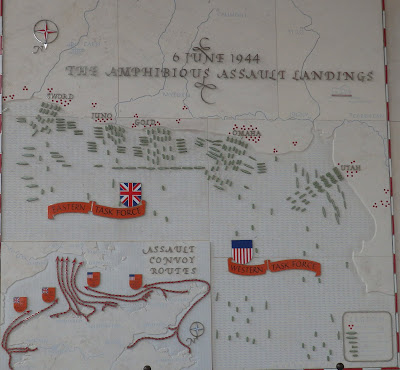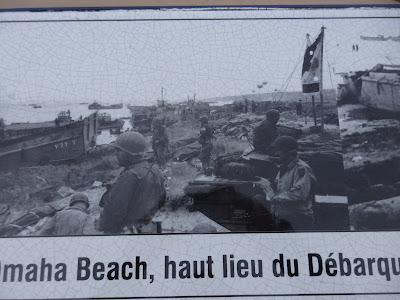 |
| If you find any of the posts hard to read, just double click them to enlarge. |
 |
| We boarded a tour bus and headed to the beaches of Normandy. This photo is just to show you what road signs in France look like. |
 |
| You can double click to enlarge but the following photos show the brochure in smaller sections. |
 |
| Our first stop was Courseulles-sur-Mer, home of Juno Beach. |
 |
| Memorials remember the fallen Canadian and French forces who landed here. |
 |
| Saw this interesting structure across the road from the cross but didn't know what it was. |
 |
| One of many bunkers that still dot the landscape. |
 |
| These structures in the water are part of the floating docks created by the British to create a supply line for the Allied troops. More on these structures later. |
 |
| This diagram shows the advance of the Canadian forces as the assault continued. |
 |
| This is a photo of the floating docks and bridges while they were in use. |
 |
| Closer view of the floating bridges |
 |
| Upon our arrival at Arromaches-les-Baines, we took a tour of the Musee de Debarquement - the Museum of Disembarking. In it was a huge model of the floating docks and bridges. |
 |
| Here you can see the poles down to the seabed. |
 |
| Empty lorries would reach the pier on the left floating road, they would be loaded on the platforms and then, they would go back to depots inland on the right floating road. |
 |
| Royal Air Force |
 |
| Flags of the participating allied countries are posted along the back side of the museum |
 |
| In front, a half-track M3 takes pride of place. |
 |
| A section of the floating road. |
 |
| Looking along the coast you can see some of the mulberry sections left. |
 |
| The steep cliffs along the coast were a huge obstacle for the forces to overcome. |
 |
| As the bus continued along the coast, it was often only one lane wide between homes in the old communities. |
 |
| Our next stop was the Normandy American Cemetery operated by the American Battle Monument Commission. The US is granted the use of the land as long as they maintain it. |
 |
| Looking down on Omaha Beach by Colleville-sur-Mer, France |
 |
| It is located on the site of the former temporary battlefield cemetery of Saint Laurent, covers 172.5 acres and contains 9,388 burials. |
 |
| The Memorial from the far side of the reflecting pool. |
 |
| Double click to enlarge for reading. This is one of the many maps displayed in the Memorial |
 |
| Double click to enlarge for reading. |
 |
| Looking from the Memorial, across the reflecting pool to the Chapel |
 |
| All religious denominations are buried together. The Star is used for a Jewish person. |
 |
| We see more sections of floating bridge as we head to Omaha Beach. |
 |
| This is the site of the first American World War II cemetery. |
 |
| A series of descriptive panels at Omaha Beach. Please double-click to read. |
 |
| The monument Les Braves is located in the center of Omaha Beach. |
 |
| Double click to read the description of Les Braves |
 |
| Double click to read the engraved message. |
 |
| Double click to see the engraving on the side of the monument. |
 |
| Glimpses of the Omaha Memorial Museum |






























































No comments:
Post a Comment